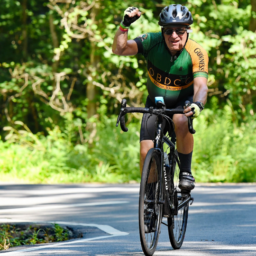So, you want to ride a bike? That’s fabulous! We’re behind you all the way. But we also want to make sure you stay safe and healthy while doing so. So, whether you’re about to take your first or fiftieth ride since your Parkinson’s diagnosis, here’s what you need to know.
#1 – Cycling is good for you
Research shows that people with Parkinson’s experience significant benefits from pushing pedals on a regular basis.
Depending upon pace and intensity, cycling has been shown to:
- Improve overall motor function
- Reduce tremor
- Reduce bradykinesia
- Reduce rigidity
- Improve aerobic capacity
- Improve mood
- Improve cognitive function
- Increase joy and social connections
- Decrease UPDRS scores (Unified Parkinson’s Disease Rating Scale)
Plus, it’s fun. Especially now. You can get outside with your friends and explore new roads, locations, and trails all while remaining socially distanced. If riding outside doesn’t feel good or safe for you, there are also plenty of stationary bike options and virtual group cycling classes to keep you moving, engaged, and connected.
 #2 – Timing is everything
#2 – Timing is everything
Before you hop on your bike, whether inside or outside, you need to be dialed in physically, emotionally, and cognitively. In other words, you need to be ON.
When you’re ON, your medications are working properly, and your symptoms are minimal or non-existent. When you’re OFF, your symptoms reappear or worsen. This could mean an increase in tremor, rigidity, slowness, stiffness, and even cognitive impairment and anxiety.
Nearly 35% of people with Parkinson’s experience OFF times (and this percentage increases with age). If you are in this camp, timing is everything when it comes to exercising.
To determine the best time to exercise, a time when you will be the most energized, focused, and ON, keep a log that tracks the timing and dosage of your medication, the times when you feel best and how long that time lasts, and when you start to feel like you’re approaching an OFF time. Then, once you have identified a clear pattern of your ON and OFF times, choose a window or windows each day when it would be best to ride.
The better you’re feeling, the better your ride will be.
#3 – Eat, drink, and be merry
What you eat and drink have a big impact on your ability to live well, and the dietary choices you make can help you reduce or avoid secondary Parkinson’s symptoms such as constipation and keep you energized and healthy overall.
However, when we’re talking about exercise, especially if it’s intense, it’s a little more complicated. That’s because some Parkinson’s medications or the progression of your Parkinson’s can raise your dehydration risk. That can be a huge problem if you’re on a bike because dehydration can lead to confusion, weakness, issues with balance, low blood pressure, and more.
To complicate matters even more, some people with Parkinson’s experience bladder problems such as a frequent and urgent need to urinate even when their bladder isn’t full. This isn’t ideal when you’re out for a long ride.
This doesn’t mean you shouldn’t ride. It just means that dialing in your diet and hydration plan can make your ride a lot more fun and even more importantly, safe.
If you don’t feel dialed in on your nutrition yet, here are a few resources to help you out:
Webinar: Parkinson’s Nutrition for Living Well
Video: Parkinson’s 101: A Video for the Newly Diagnosed (Dr. K shares detailed and practical advice on food timing and combining to increase ON times for people living with Parkinson’s.)
Article: The 17 Most Commonly Asked Questions About Parkinson’s Nutrition
#4 – Balance matters
Exercises like cycling that challenge your balance, hand-eye coordination, and fine motor control are important components of any exercise plan, especially for people with Parkinson’s. But because these same exercises can increase the risk of dangerous falls if you experience problems with balance, it’s important to remember the advice about ON and OFF times and to plan your rides mindfully.
A stationary bike is an ideal option for days and times when the weather is uncooperative, a biking buddy is hard to find, or you’re feeling less than confident about heading out on an outdoor biking excursion. Many stationary bike options such as Wahoo KICKR Bike, Peloton, NordicTrack cycle, Bowflex, and Myx Fitness allow you to ride in the comfort of your home while still connecting to others through virtual classes.
Balance isn’t just physical, though. Whether planning your next cycling adventure or your weekend to-do list, remember that life is all about balance. There are good days and bad days, highs and lows, bright spots and challenges. On days when you may feel off-balance, shift your focus to the ways you can live well in the moment.

#5 – Buddy up
A lot can happen when you’re out on the bike. Traffic, other riders, construction, road debris, and unexpected weather are normal parts of being out in the world. So, having a buddy can literally be a lifesaver. They can be another set of eyes and ears, they are another set of hands if something goes wrong with your bike, and they can recognize when you’re OFF or heading that way.
While it may not always be easy to coordinate with friends’ schedules, it’s worth it to do so. Never ride alone. And if you must, make sure you’re doing it on a stationary bike.

#6 – Bring back up
Before you go out on your next ride, create your back-up kit. In addition to an extra tube, tire irons, etc., your kit should include the following:
- Extra meds + medication list and contraindications
- Extra food
- Money
- Emergency notification device
- Phone
- In case of emergency (ICE) contacts
You can put it together in just a few minutes, and you can take it with you whether you’re getting on a bike, taking a walk, or driving to the store. Don’t leave home without it.
#7 – It’s supposed to be fun
For all the reasons listed above and more, cycling is an ideal activity for people with Parkinson’s. But it’s also just a fun way to spend time with friends, destress, and enjoy life.
No matter where you live, there is likely a biking group nearby that you could join. We often hear from riders who join cycling groups that they fall in love with more than just riding; they fall in love with the people they meet and the friendships they form in the biking community.
Biking can help you set new goals and stay motivated to reach them. It can also be a powerful tool to raise funds for causes you care about or contribute to new research being conducted about cycling’s effects on Parkinson’s.
 Resources
Resources
We hope you’ll consider all of the above before you head out on your next ride. (Check out RideSpot.org to discover and share great bike rides.) And if you need to buy a ride before you can go for one, here’s some info on how to choose the best bike for you.
Want to set yourself up indoors and connect to others who are riding indoors? Check out the virtual Pedaling For Parkinson’s™ schedule here.
Want More Practical Articles Like This?
Much more can be found in our Every Victory Counts® manual. It’s packed with up-to-date information about everything Parkinson’s, plus an expanded worksheets and resources section to help you put what you’ve learned into action. Request your free copy of the Every Victory Counts manual by clicking the button below.
Thank you to our 2020 Peak Partners, Amneal and Kyowa Kirin, with special support from Adamas, for helping us make printing, distributing, and shipping the Every Victory Counts manual for free possible.

















